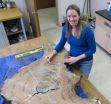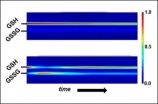(Press-News.org) EUGENE, Ore. -- (Feb. 12, 2014) -- Research led by a University of Oregon doctoral student in California's Santa Cruz Mountains has uncovered geologic evidence that supports historical narratives for two earthquakes in the 68 years prior to San Francisco's devastating 1906 disaster.
The evidence places the two earthquakes, in 1838 and 1890, on the San Andreas Fault, as theorized by many researchers based on written accounts about damage to Spanish-built missions in the Monterey and San Francisco bay areas. These two quakes, as in 1906, were surface-rupturing events, the researchers concluded.
Continuing work, says San Francisco Bay-area native Ashley R. Streig, will dig deeper into the region's geological record -- layers of sediment along the fault -- to determine if the ensuing seismically quiet years make up a normal pattern -- or not -- of quake frequency along the fault.
Streig is lead author of the study, published in this month's issue of the Bulletin of the Seismological Society of America. She collaborated on the project with her doctoral adviser Ray Weldon, professor of the UO's Department of Geological Sciences, and Timothy E. Dawson of the Menlo Park office of the California Geological Survey.
The study was the first to fully map the active fault trace in the Santa Cruz Mountains using a combination of on-the-ground observations and airborne Light Detection and Ranging (LiDAR), a remote sensing technology. The Santa Cruz Mountains run for about 39 miles from south of San Francisco to near San Juan Batista. Hazel Dell is east of Santa Cruz and north of Watsonville.
"We found the first geologic evidence of surface rupture by what looks like the 1838 and 1890 earthquakes, as well as 1906," said Streig, whose introduction to major earthquakes came at age 11 during the 1989 Loma Prieta Earthquake on a deep sub-fault of the San Andreas Fault zone. That quake, which disrupted baseball's World Series, forced her family to camp outside their home.
Unlike the 1906 quake that ruptured 470 km (296 mi) of the fault, the 1838 and 1890 quakes ruptured shorter portions of the fault, possibly limited to the Santa Cruz Mountains. "This is the first time we have had good, clear geologic evidence of these historic 19th century earthquakes," she said. "It's important because it tells us that we had three surface ruptures, really closely spaced in time that all had fairly large displacements of at least half a meter and probably larger."
The team identified ax-cut wood chips, tree stumps and charcoal fragments from early logging efforts in unexpectedly deep layers of sediment, 1.5 meters (five feet) below the ground, and document evidence of three earthquakes since logging occurred at the site. The logging story emerged from 16 trenches dug in 2008, 2010 and 2011 along the fault at the Hazel Dell site in the mountain range.
High-resolution radiocarbon dating of tree-rings from the wood chips and charcoal confirm these are post European deposits, and the geologic earthquake evidence coincides with written accounts describing local earthquake damage, including damage to Spanish missions in 1838, and in a USGS publication of earthquakes in 1890 catalogued by an astronomer from Lick Observatory.
Additionally, in 1906 individuals living near the Hazel Dell site reported to geologists that cracks from the 1906 earthquake had occurred just where they had 16 years earlier, in 1890, which, Streig and colleagues say, was probably centered in the Hazel Dell region. Another displacement of sediment at the Hazel Dell site matched the timeline of the 1906 quake.
The project also allowed the team to conclude that another historically reported quake, in 1865, was not surface rupturing, but it was probably deep and, like the 1989 event, occurred on a sub zone of the San Andreas Fault. Conventional thinking, Streig said, has suggested that the San Andreas Fault always ruptures in a long-reaching fashion similar to the 1906 earthquake. This study, however, points to more regionally confined ruptures as well.
"This all tells us that there are more frequent surface-rupturing earthquakes on this section of the fault than have been previously identified, certainly in the historic period," Streig said. "This becomes important to earthquake models because it is saying something about the connectivity of all these fault sections -- and how they might link up."
The frequency of the quakes in the Santa Cruz Mountains, she added, must have been a terrifying experience for settlers during the 68-year period.
"This study is the first to show three historic ruptures on the San Andreas Fault outside the special case of Parkfield," Weldon said, referring to a region in mountains to the south of the Santa Cruz range where six magnitude 6-plus earthquakes occurred between 1857 and 1966. "The earthquakes of 1838 and 1890 were known to be somewhere nearby from shaking, but now we know the San Andreas Fault ruptured three times on the same piece of the fault in less than 100 years."
More broadly, Weldon said, having multiple paleoseismic sites close together on a major fault, geologists now realize that interpretations gleaned from single-site evidence probably aren't reliable. "We need to spend more time reproducing or confirming results rather than rushing to the next fault if we are going to get it right," he said. "Ashley's combination of historical research, C-14 dating, tree rings, pollen and stratigraphic correlation between sites has allowed us to credibly argue for precision that allows identification of the 1838 and 1890 earthquakes."
"Researchers at the University of Oregon are using tools and technologies to further our understanding of the dynamic forces that continue to shape our planet and impact its people," said Kimberly Andrews Espy, vice president for research and innovation and dean of the UO Graduate School. "This research furthers our understanding of the connectivity of the various sections of California's San Andreas Fault and has the potential to save lives by leading to more accurate earthquake modeling."
INFORMATION:
The U.S. Geological Survey funded the research through grants 08-HQ-GR-0071, 08-HQ-GR-0072, G10AP00064, G10AP0065 and G11AP20123. A Geological Society of America Student Research Grant to Streig funded the age-dating of the team's evidence at the Lawrence Livermore National Laboratory's Center for Accelerator Mass Spectrometry.
About the University of Oregon
The University of Oregon is among the 108 institutions chosen from 4,633 U.S. universities for top-tier designation of "Very High Research Activity" in the 2010 Carnegie Classification of Institutions of Higher Education. The UO also is one of two Pacific Northwest members of the Association of American Universities.
Sources: Ashley Streig, doctoral candidate, Department of Geological Sciences, 541-346-4647, streig@uoregon.edu, and Ray Weldon, professor of geological sciences, 541-346-4584, ray@uoregon.edu
Links:
Streig webpage: http://geology.uoregon.edu/profile/streig/
Department of Geological Sciences: http://geology.uorgon.edu
Weldon faculty page: http://geology.uoregon.edu/profile/ray/
USGS site on 1906 S.F. earthquake: http://earthquake.usgs.gov/regional/nca/1906/18april/index.php
Follow UO Science on Facebook: http://www.facebook.com/UniversityOfOregonScience
UO Science on Twitter: http://twitter.com/UO_Research
More UO Science/Research News: http://uoresearch.uoregon.edu
Note: The University of Oregon is equipped with an on-campus television studio with a point-of-origin Vyvx connection, which provides broadcast-quality video to networks worldwide via fiber optic network. In addition, there is video access to satellite uplink, and audio access to an ISDN codec for broadcast-quality radio interviews.
San Francisco's big 1906 quake was third of a series on San Andreas Fault
University of Oregon-led team confirms ground-rupturing events that match up with historical records
2014-02-12
ELSE PRESS RELEASES FROM THIS DATE:
Clever NIST/JPL technology decodes more information from single photons
2014-02-12
It's not quite Star Trek communications—yet. But long-distance communications in space may be easier now that researchers at the National Institute of Standards and Technology (NIST) and Jet Propulsion Laboratory (JPL) have designed a clever detector array that can extract more information than usual from single particles of light.
Described in a new paper,* the NIST/JPL array-on-a-chip easily identifies the position of the exact detector in a multi-detector system that absorbs an incoming infrared light particle, or photon. That's the norm for digital photography cameras, ...
New NIST method evaluates response to oxidation in live cells
2014-02-12
Researchers at the National Institute of Standards and Technology (NIST) have developed a new method for accurately measuring a key process governing a wide variety of cellular functions that may become the basis for a "health checkup" for living cells.
The NIST technique measures changes in a living cell's internal redox (reduction-oxidation) potential, a chemistry concept that expresses the favorability of reactions in which molecules or atoms either gain or lose electrons. Redox reactions are important to cell chemistry because they regulate many genes and the proteins ...
Popular disinfectants do not kill HPV
2014-02-12
Commonly used disinfectants do not kill human papillomavirus (HPV) that makes possible non-sexual transmission of the virus, thus creating a need for hospital policy changes, according to researchers from Penn State College of Medicine and Brigham Young University.
"Because it is difficult to produce infectious HPV particles for research, little has been known about HPV susceptibility to disinfection," said Craig Meyers, Distinguished Professor of Microbiology and Immunology, Penn State College of Medicine.
Use of disinfectants on HPV in health care settings has been ...
Hollywood failing to keep up with rapidly increasing diversity, UCLA study warns
2014-02-12
When it comes to influential positions in the entertainment industry, minorities and women are represented at rates far below what would be expected given their percentage of the general population, according to a new study done at UCLA's Ralph J. Bunche Center for African American Studies.
In fact, the report shows, the proportion of female and minority actors, writers, directors and producers in films and TV ranges from just one-twelfth to one-half of their actual population percentage.
"The report paints a picture of an industry that is woefully out of ...
Meeting the eye-witnesses of ocean change
2014-02-12
Members of the German research network BIOACID (Biological Impacts of Ocean Acidification) are developing a model that links ecosystem changes triggered by ocean acidification and climate change with their economic and societal consequences. Workshops and interviews with stakeholders from the Norwegian fishing industry and tourism sector, the government and environmental organisations help them to identify key aspects for their assessment.
During the past ten years, scientists have learned a lot about the effects of ocean acidification on marine ecosystems. It has become ...
Cities support more native biodiversity than previously thought
2014-02-12
(Santa Barbara, Calif.) — The rapid conversion of natural lands to cement-dominated urban centers is causing great losses in biodiversity. Yet, according to a new study involving 147 cities worldwide, surprisingly high numbers of plant and animal species persist and even flourish in urban environments — to the tune of hundreds of bird species and thousands of plant species in a single city.
Contrary to conventional wisdom that cities are a wasteland for biodiversity, the study found that while a few species — such as pigeons and annual meadow grass — are shared across ...
4 years on, ICU Patients with kidney injury show high mortality & elevated urinary protein
2014-02-12
In 4 years of follow up of 1464 participants in the randomized controlled trial Randomised Evaluation of Normal vs. Augmented Levels of RRT (RENAL) study, Martin Gallagher (The George Institute for Global Health, Sydney, Australia) and colleagues found that patients with acute kidney injury (AKI) in an intensive care unit (ICU) who require renal replacement therapy (RRT; hemodialysis combined with hemofiltration) do not benefit from higher intensity RRT. At a median of 43.9 months follow up, mortality (63% in the low intensity and 63% in the high intensity group), as well ...
Study challenges a close link between recent weight gain and diabetes
2014-02-12
It is a common notion that type 2 diabetes is precipitated by substantial progressive weight gain, but a study published this week in PLOS Medicine suggests that this might not be true.
Dorte Vistisen and Kristine Færch, from the Steno Diabetes Center in Gentofte, Denmark, and colleagues analyzed data from participants of the Whitehall II cohort, a group of London-based civil servants who have been followed for more than a decade, to see what changes in body weight and other parameters had occurred in people in the years before they were diagnosed with diabetes.
6,705 ...
What makes memories last?
2014-02-12
Prions can be notoriously destructive, spurring proteins to misfold and interfere with cellular function as they spread without control. New research, publishingin the open access journal PLOS Biology on February 11 2014, from scientists at the Stowers Institute for Medical Research reveals that certain prion-like proteins, however, can be precisely controlled so that they are generated only in a specific time and place. These prion-like proteins are not involved in disease processes; rather, they are essential for creating and maintaining long-term memories.
"This protein ...
Fifty-five genes linked to a powerful tumor suppressor predict breast cancer survival
2014-02-12
WASHINGTON — A panel of 55 genes, almost all of which are impacted by the loss of a particular protein, appears to predict if breast cancer will become invasive, leading to poorer survival, researchers at Georgetown Lombardi Comprehensive Cancer Center report in PLOS ONE.
The panel represents loss of a powerful tumor suppressor gene, SYK, as well as genetic alterations in 51 other genes that are directly affected by the loss of a copy of the SYK gene and the absence of its protein.
"Without SYK, the protein it makes, and genetic disruption in a set of genes thought ...
LAST 30 PRESS RELEASES:
Geometry shapes life
A CRISPR screen reveals many previously unrecognized genes required for brain development and a new neurodevelopmental disorder
Hot flush treatment has anti-breast cancer activity, study finds
Securing AI systems against growing cybersecurity threats
Longest observation of an active solar region
Why nail-biting, procrastination and other self-sabotaging behaviors are rooted in survival instincts
Regional variations in mechanical properties of porcine leptomeninges
Artificial empathy in therapy and healthcare: advancements in interpersonal interaction technologies
Why some brains switch gears more efficiently than others
UVA’s Jundong Li wins ICDM’S 2025 Tao Li Award for data mining, machine learning
UVA’s low-power, high-performance computer power player Mircea Stan earns National Academy of Inventors fellowship
Not playing by the rules: USU researcher explores filamentous algae dynamics in rivers
Do our body clocks influence our risk of dementia?
Anthropologists offer new evidence of bipedalism in long-debated fossil discovery
Safer receipt paper from wood
Dosage-sensitive genes suggest no whole-genome duplications in ancestral angiosperm
First ancient human herpesvirus genomes document their deep history with humans
Why Some Bacteria Survive Antibiotics and How to Stop Them - New study reveals that bacteria can survive antibiotic treatment through two fundamentally different “shutdown modes”
UCLA study links scar healing to dangerous placenta condition
CHANGE-seq-BE finds off-target changes in the genome from base editors
The Journal of Nuclear Medicine Ahead-of-Print Tip Sheet: January 2, 2026
Delayed or absent first dose of measles, mumps, and rubella vaccination
Trends in US preterm birth rates by household income and race and ethnicity
Study identifies potential biomarker linked to progression and brain inflammation in multiple sclerosis
Many mothers in Norway do not show up for postnatal check-ups
Researchers want to find out why quick clay is so unstable
Superradiant spins show teamwork at the quantum scale
Cleveland Clinic Research links tumor bacteria to immunotherapy resistance in head and neck cancer
First Editorial of 2026: Resisting AI slop
Joint ground- and space-based observations reveal Saturn-mass rogue planet
[Press-News.org] San Francisco's big 1906 quake was third of a series on San Andreas FaultUniversity of Oregon-led team confirms ground-rupturing events that match up with historical records



